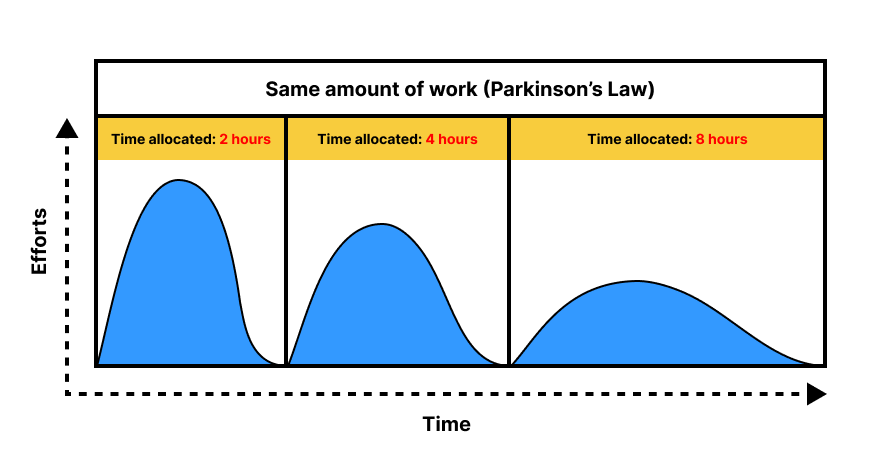Introduction
Rules and Laws guide the changing world of User Experience (UX). Presenting and Creating a smooth, fun and enjoyable experience. Parkinson's Law has a huge impact on User Experience Designers and Corporate professionals, where there is a limited time to do anything, and how to solve it makes this Law stand out.
In an article published in 1955, Cyril Northcote Parkinson wrote:
"Work expands to fill the time available for its completion."
This statement perfectly encapsulates the essence of Parkinson's Law.
First used in government and organisations, Parkinson's Law is still active in User Experience Design, providing guidance about how to engage with users efficiently and increase productivity.
Understanding Parkinson’s Law in the Context of UX Design:
Parkinson's Law forces designers to rethink how they handle resource allocation, job prioritisation, and time management during the UX design process. Adopting Parkinson's Law ideas can enable designers to improve user experiences, streamline workflows, and eliminate inefficiencies in the fast-paced digital world, where user expectations are still rising.

Key Principles and Applications of Parkinson’s Law in UX Design:
Time Constraints Drive Creativity and Focus:
Parkinson's Law highlights the importance of establishing exact time limits and deadlines throughout the design phase. Designers are forced to prioritise activities, make choices quickly, and better focus their creative efforts when the time allotted for each project phase is limited. This sense of hurry keeps projects from sitting in a never-ending cycle of iteration and promotes creativity and teamwork.
Scope Management and Feature Prioritisation:
Parkinson's Law states that UX designers should avoid giving in to scope creep and feature bloat. Rather, they must take a brutal approach to selecting which features are most important depending on how well they will engage and satisfy users. Designers can keep projects from going out of hand and guarantee the timely delivery of high-quality experiences by concentrating on the key features that match user wants and company goals.
Agile Methodologies and Iterative Design:
Parkinson's Law encourages a flexible, iterative method of UX design typified by frequent feedback loops, user testing, and quick prototyping. Designers can keep up with the pace, make real-time design revisions, and adjust to changing consumer tastes and market conditions by decomposing large projects into smaller, more manageable jobs. Teams can quickly reverse course, proactively address usability concerns, and provide solutions that end users find compelling thanks to this iterative design-build-test cycle.

Real-Life Examples and Case Studies:
To illustrate the practical applications of Parkinson’s Law in UX design, let us consider a real-life case study:
Example 1: Mobile Banking App
Challenge: A leading bank wanted to improve its mobile banking app so more people would use it and keep using it.
Approach:
The design team used an agile methodology with short sprints and regular checkpoints to assess progress and fix issues in real-time, applying Parkinson's Law. The team prioritised bill payments, cash transfers, and account balance tracking to create essential functionality matching user preferences and company objectives.
Outcome:
The mobile banking software had a revamp that exceeded customers' expectations, receiving positive feedback for its easy-to-use navigation, better security measures, and intuitive UI. Following tight deadlines and utilising Parkinson's Law, the design team produced a flawless product that surpassed user expectations and significantly improved in-app engagement and customer satisfaction.
Example 2: Project Deadline
Scenario: A software development company is creating a new mobile app for a client. The project manager calculated the estimated completion date of three months. The project can easily be completed in two months, but the team will take three months to complete it, and the additional one month of available time will be filled with something unnecessary.
Case Study: When the project starts, the group moves very quickly. But as the deadline draws near, the crew runs into unexpected technical problems and scope creep. Scope creep means how requirements of projects increase over time and mostly happens when a project is about to finish. The team works until the last minute, adding pointless features and wasting too much time on little things instead of changing the scope or developing more effective solutions. Even though the work needed was doable in the first three months, the project required six months to complete—twice as long as originally projected. This perfectly illustrates Parkinson's Law, wherein labour grows to occupy the available time.
Example 3: Office Tasks
Scenario:
In a corporate office setting, employees are given a certain number of tasks to complete each day. Despite a standard eight-hour workday, some employees consistently work late to complete their tasks.
Case Study:
A series of duties is assigned to Employee A, who has to finish them before the end of the workday. Employee A procrastinates throughout the day, chatting with coworkers, attending pointless meetings, and checking emails excessively instead of setting priorities and doing the chores quickly. Employee A remains late to accomplish their work after realising they haven't finished it by the end of the day. The tasks take ten hours to accomplish, even though they should only take eight because of inefficiencies brought on by procrastination and poor time management. Because of inadequate time management and prioritisation, the chores grew to fill the available time, an example of Parkinson's Law.
Conclusion: Embracing Efficiency and Effectiveness in UX Design
To summarise, Parkinson's Law is a useful guide for UX designers who want to simplify their processes, increase output, and provide great user experiences. By adopting time limits, agile approaches, and scope management, designers can achieve new heights of creativity, innovation, and efficiency in their design process. Parkinson's Law will continue to be a vital resource for designers looking to create meaningful, memorable, and user-centred experiences in the digital era as the landscape of design changes.
By applying the knowledge gained from Parkinson's Law, UX designers may set out on a path of invention, iteration, and continual improvement, ensuring that their designs stay compelling, memorable, and relevant in a constantly changing world. Designers may exceed limitations, challenge assumptions, and expand the parameters of possibility in the field of user experience design by utilising Parkinson's Law.
Thank you for reading this article. See you in the next one.
